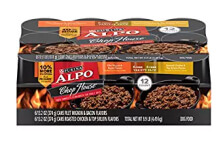It is important to be prepared in times of disaster. Stockpiling on food, however, does not mean provisions for members of the family only. Dogs are not just pets to play and cuddle. They are family members, too. If you own one, the best thing to do is to have an idea on prepper dog food storage that will ensure access to safe and edible treats essential for their health and well-being. When thinking of preparing for any form of disaster, the following tips can be of help:

Source: pinterest.com
1. Start by buying quality dog food. Initiate a prepper dog food storage by building a 3-month supply of quality canine products. Do not buy edible items all at once as you may face a dilemma during rotation. Keep in mind that these products often have one-year expiry. They may still be deemed edible but nutritional content may be diminished. If possible, go for specially-packed dog food like this Mayday Emergency Survival Dog Food which can last for 5 years.
2. Choose the best location. As a rule of thumb, your food storage area must be in a cool, dry place under 80-degree F. Regardless of human or pet food, any area with temperature as high as 100-deg F can easily ruin quality of food. It will not only subject such to high humidity but more so to harmful microorganisms and molds. Also, make sure that dog food and treats are kept away from sunlight, too.
3. Keep it sealed. As much as possible, keep unused dog food (dry kibble) inside its original bag and stashed into a dedicated container. When opened, keep the top portion folded to create an airtight seal. Like human food, it is also wise to choose non-clear BPA-free plastic airtight container like the Vittles Vault Stackable Pet Food Container below, and label them accordingly. Indicate date of purchase and stipulated expiration date. This container helps to prevent pet food from going stale while keeping odor contained inside. This container can also hold 50pounds of pet food.
3. Repacking no-nos. As a rule of thumb, it is not recommended to repack dry dog food into Mylar packs or vacuum-sealed bags for long-term storage. Rotation schedule must be done every 6 months to one year by using the FIFO (first-in, first-out) scheme. Dry kibbles can still develop moisture from fat and oil content which can build up inside these containers making them go rancid overtime– even with oxygen absorbers or silica packets.
4. Always do weekly checks. Rotation of your dog food supply must be carefully monitored. As mentioned, fats and oils in dry kibbles can build up and make the whole bag go rancid without even exposing it. Thus, it is wise to keep a keen eye on your pet’s food appearance as well as the smell. When something is off before expiry date printed on the bag, return it to the manufacturer or have it returned to the place of purchase.
5. Have canned dog food handy, too. Many preppers who have canine pets highly recommend stocking up on canned goods like the Purina ALPO Chop House Wet Dog Food as they can last for up to 5 year. Cost-wise, a year’s supply of dog food in cans is quite inexpensive, longer lasting and takes less storage space than dry bagged kibbles. They do not require added container but simply a cool, dry place that’s not exposed to sunlight. Canned goods are also completely sealed preventing any microorganisms from penetrating deep within. Just make sure to wipe away the lid before opening for consumption of your pet.
6. Go freeze-dried! Aside from canned goods, freeze-dried dog food and treats are also excellent choices as prepper dog food. Aside from longer lasting with less chances of contamination, it is also convenient and lightweight enough to be stashed in a bugout backpack should there is a need to flee your home due to emergency circumstances. Simply have them packed into Mylar pack with oxygen absorbers and silica packets.

Source: aspca.org
Overall, learning proper prepper dog food storage should be considered a necessity to homes with canine pets. Remember to keep these guidelines in mind when thinking of arranging storage. And while there are various dog food types for you to choose from– dry kibble, canned or freeze-dried– it is prudent to learn how to make your own pet food, too. There are hundreds, if not thousands, of recipes that can help you meet your beloved canine friend’s requirement even when bunked out in the wild. As always, safety of the whole family must be the end goal in mind– and this, of course, includes your dog.







Leave a Reply
You must be logged in to post a comment.